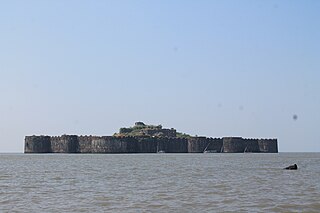
Bajirao I was the 7th and greatest Peshwa of the Maratha Confederacy. He, after Shivaji, is considered to be the most charismatic and dynamic leader in Maratha history. He was just twenty years old and already had a reputation for rapid decisions and a passion for military adventure.

Sambhaji, also known as Shambhuraje, was the second Chhatrapati of the Maratha Kingdom, ruling from 1681 to 1689. He was the eldest son of Shivaji, the founder of the Maratha Kingdom. Sambhaji's rule was largely shaped by the ongoing wars between the Marathas and the Mughal Empire, as well as other neighbouring powers such as the Abyssinians of Janjira, Wadiyars of Mysore and the Portuguese Empire in Goa. After Sambhaji's execution by Aurangzeb, his brother Rajaram I succeeded him as the next Chhatrapati and continued the Mughal–Maratha Wars.

The Maratha Confederacy, also referred to as the Maratha Empire, was an early modern polity in the Indian subcontinent. It comprised the realms of the Peshwa and four major independent Maratha states often subordinate to the former. It was established in 1674 with the coronation of Shivaji as the Maratha Chhatrapati and recognised by Emperor Bahadur Shah I as a tributary state in 1707 following a prolonged rebellion. Following this, the Marathas continued to recognise the Mughal emperor as their nominal suzerain, similar to other contemporary Indian entities, though in practice, imperial politics at Delhi were largely influenced by the Marathas between 1737 and 1803.

The Peshwa was the second highest office in the Maratha Confederacy, next in rank and prestige only to that of the Chhatrapati. Initially serving as the appointed prime minister in the Maratha Kingdom, the office became hereditary after the death of Shahu in 1749. During the reign of Shahu, the office of Peshwa grew in power and the Peshwas came to be the de facto rulers of the Maratha Confederacy. However following the defeat of the Marathas in 1761, the office of the Peshwa became titular as well and from that point onwards served as the ceremonial head of the Confederacy underneath the Chhatrapati.

Kanhoji Angre, also known as Conajee Angria or Sarkhel Angré was a Maratha Navy officer. Kanhoji became known for attacking and capturing European East Indiamen and collecting jakat, seen by Europeans traders and colonists as ransoming of their crews. British, Dutch and Portuguese ships often fell victims to these raids.Despite attempts by the Portuguese and British to put an end to his privateering activities, Angre continued to capture and collect jakat from European merchant ships until his death in 1729. Kanhoji's naval prowess in capturing dozens of European trading ships and avoiding capture has led to many historians to appraise Kanhoji as the most skilled Indian navy chief in the maritime history of India.

Balaji Vishwanath Bhat was the first of a series of hereditary Peshwas hailing from the Bhat family who gained effective control of the Maratha Confederacy and other Mughal vassals during the early 18th century. Balaji Vishwanath assisted a young Maratha king Shahu to consolidate his grip on a kingdom that had been racked by civil war and persistently intruded on by the Mughals under Aurangzeb. He was called the Second Founder of the Maratha State. He secured a grant from the Mughal court that confirmed Shahu as the legitimate Mughal vassal, at the expense of his rival Sambhaji II. Later, his son Bajirao I became the Peshwa.

Murud-Janjira is the local name of a famous fort and tourist spot situated on an island just off the coastal town of Murud, in the Raigad district of Maharashtra, India. Malik Ambar is credited with the construction of the Janjira Fort in the Murud Area of present-day Maharashtra India. After its construction in 1567 AD, the fort was key to the Sidis withstanding various invasion attempts by the Marathas, Mughals, and Portuguese to capture Janjira.
Murud is a town and a municipal council in Raigad district in the Indian state of Maharashtra. Situated at a distance of 150 km (93 mi) from Mumbai, Murud is a tourist destination. The Palace of Nawab is located in Murud. The palace was built in 1885 for administration purposes. The palace is still owned by the descendants of the Nawab and is a private property.
Qasim Yakut Khan also known as Yakut Shaikhji, Yakub Khan and Sidi Yaqub was a naval Admiral and administrator of Janjira Fort who first served under Bijapur Sultanate and later under the Mughal Empire.

Vijaydurg, the oldest fort on the Sindhudurg coast, was constructed during the regime of Raja Bhoja II of the Shilahar dynasty and restructured by Shivaji.
The Patil is a title used by Koli chiefs of villages in Maharashtra.
Bahirji Naik,, was a 17th century Maratha spy and head of intelligence department in the army of Shivaji. Bahirji was honoured with title of "Naik" (transl. Chief) by King Shivaji due to his great work.

Janjira State was a princely state in India during the British Raj. Governor of the Siddi dynasty, Habesha descent and the state was under the suzerainty of the Bombay Presidency.

The Maratha Navy was the naval wing of the armed forces of the Maratha Confederacy, which existed from around the mid-17th century to the mid-18th century in the Indian subcontinent.
Annaji Datto Sachiv was the Sachiv in the Ashta Pradhan mandal of the Maratha Empire during the rule of Shivaji.

The Raja Ram Rao Patil or Itbarrao Koli was an Admiral of the Ahmadnagar Navy and Koli ruler of Janjira. Patil built and fortified the Janjira Island.
The Maharaja Soma Shah was Koli ruler of the petty kingdom of Ramnagar, present days in Gujarat. He invented the Chauth system which was a form of the Protection fees.

Kherojirao Pattikar was Koli subedar in the Maratha Army of Maratha Empire during the reign of Maratha ruler Chhatrapati Shivaji.

The Siege of Janjira was a military campaign undertaken by the Maratha Confederacy, commanded by Sambhaji, the second Maratha ruler, against the Siddis of Janjira in January 1682. The Maratha forces, led by Sambhaji, withdrew from Janjira to the Konkan region in response to Mughal attacks, leaving a contingent behind under the command of Dadaji Raghunath Deshpande. Despite their efforts, the Marathas were unable to capture the fort, and the Siddis pursued the retreating forces, plundering Maratha territories.

The Shivaji's invasions of Janjira were a series of military campaigns launched by the first Maratha ruler, Shivaji, against the Abyssinian rulers of the sea fortress of Janjira named Siddis between 1661 and 1676. The Marathas attacked the Janjira fort annually, and during the final siege of 1676, the Maratha Peshwa Moropant faced a counterattack by the Siddis, forcing the Marathas to retreat with heavy casualties.














